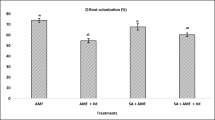Abstract
Pretreatment of soil with the herbicide acetochlor at 0.1–1μg g−1 significantly decreased incidence of wilt due toFusarium oxysporum f. sp.melonis in melon seedlings. Glucose, fructose and sucrose increased in leaves of inoculated and uninoculated melon plants following acetochlor treatment. The increase in sugar levels in stems and roots was less pronounced. Light intensity affected sugar content and disease incidence. The percentage of diseased plants was significantly higher in untreated plants grown under 165μE m−2 sec−1 compared to plants grown under 300μE m−2 sec−1. Lowering light intensity resulted in reduction of levels of total sugars on the third and sixth day after inoculation. Acetochlor had little or no effect on growth rate or sporulation of the pathogen in culture. The colonization rate of diseased plant stems by the pathogen was similar in herbicide-treated and untreated plants, thus excluding the possibility that disease reduction by the herbicide is related to direct fungitoxicity.
Similar content being viewed by others
References
Alon H, Katan J and Kedar N (1974) Factors affecting penetrance of resistance toFusarium oxysporum f. sp.lycopersici in tomatoes. Phytopathology 64: 455–461
Altman J and Campbell CL (1977) Effect of herbicides on plant diseases. Annu. Rev. Phytopathol. 15: 361–385
Bell AA and Mace ME (1981) Biochemistry and physiology of resistance. In: Mace ME, Bell AA and Beckman CH (eds) Fungal Wilt Diseases of Plants (pp. 431–477) Academic Press, New York
Ben-Yephet Y, Mhameed S, Frank ZR and Katan J (1991) Effect of the herbicide ethal-fluralin on net blotch disease of peanut pods. Plant Dis 75: 1123–1126
Biehn WL and Dimond AE (1971) Effect of galactose on polygalacturonase production and pathogenesis byFusarium oxysporum f. sp.lycopersici. Phytopathology 61: 242–243
Bolter C, Brammall R, Cohen R and Lazarovits G (1993) Glutathione alterations in melon and tomato roots following treatment with chemicals which induce disease resistance to Fusarium wilt. Physiol Mol Plant Pathol 42: 321–336
Buchenauer H and Erwin DC (1976) Effect of the plant growth retardant pydanon onVerticillium wilt of cotton and tomato. Phytopathology 66: 1140–1143
Cohen R, Blaier B and Katan J (1992a) Chloroacetamide herbicides reduce incidence of Fusarium wilt in melons. Crop Prot 11: 181–185
Cohen R, Cuppels DA, Brammall RA and Lazarovits G. (1992b) Induction of resistance towards bacterial pathogens of tomato by exposure of the host to dinitroaniline herbicides. Phytopathology 82: 110–114
Cohen R, Riov J, Lisker N and Katan J (1986) Involvement of ethylene in herbicide-induced resistance toFusarium oxysporum f. sp.melonis. Phytopathology 76: 1281–1285
Cohen R, Yarden O, Katan J, Riov J and Lisker N (1987) Paclobutrazol and other plant growth-retarding chemicals increase resistance of melon seedlings to fusarium wilt. Plant Pathol 36: 558–564
Fuerst EP (1987) Understanding the mode of action of the chloroacetamide and thiocarbamate herbicides. Weed Technol 1: 270–277
Grinstein A, Katan J and Eshel Y (1976) Effect of dinitroaniline herbicides on plant resistance to soilborne pathogens. Phytopathology 66: 517–522
Grinstein A, Lisker N, Katan J and Eshel Y (1984) Herbicide-induced resistance to plant wilt diseases. Physiol Plant Pathol 24: 347–356
Horsfall JG and Dimond AE (1957) Interactions of tissue sugars, growth substances and disease susceptibility. Z. Pflanzenkr. Pflanzenpathol. Pflanzenschutz 64: 415–421
Katan J and Eshel Y (1973) Interactions between herbicides and plant pathogens. Residue Rev 45: 145–177
Miller GL (1959) Use of dinitrosalicylic acid reagent for determination of reducing sugar. Anal Chem 31: 426–428
Neubauer R and Avizohar-Hershenson Z (1973) Effect of the herbicide trifluralin on rhizoctonia disease in cotton. Phytopathology 63:651–652
Patil SS and Dimond AE (1968) Repression of polygalacturonase synthesis ofFusarium oxysporum f. sp.lycopersici by sugars and its effect on symptom reduction in infected tomato plants. Phytopathology 58: 676–682
Puhalla JE and Bell AA (1981) Genetics and biochemistry of wilt pathogens. In: Mace ME, Bell AA and Beckman CH (eds) Fungal Wilt Diseases of Plants (pp. 145–153) Academic Press, New York
Schaffer AA, Nerson H and Zamski E (1991) Premature leaf chlorosis in cucumber associated with high starch accumulation. J Plant Physiol 138: 186–190
Thivend P, Mercier C and Guilbot A (1972) Determination of starch with glucomylase. In: Wistler RL and BeMiller JN (eds.) Methods in Carbohydrate Chemistry. Vol. 6 (pp. 100–105) Academic Press, New York
Van Handel E (1968) Direct microdetermination of sucrose. Anal Biochem 22: 280–283
Author information
Authors and Affiliations
Additional information
Contribution from the Agricultural Research Organization. No. 1560-E, 1995 series.
Rights and permissions
About this article
Cite this article
Cohen, R., Blaier, B., Schaffer, A.A. et al. Effect of acetochlor treatment on Fusarium wilt and sugar content in melon seedlings. Eur J Plant Pathol 102, 45–50 (1996). https://doi.org/10.1007/BF01877114
Accepted:
Issue Date:
DOI: https://doi.org/10.1007/BF01877114




